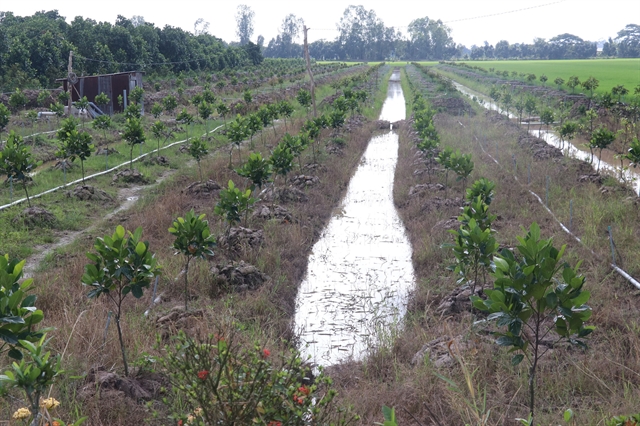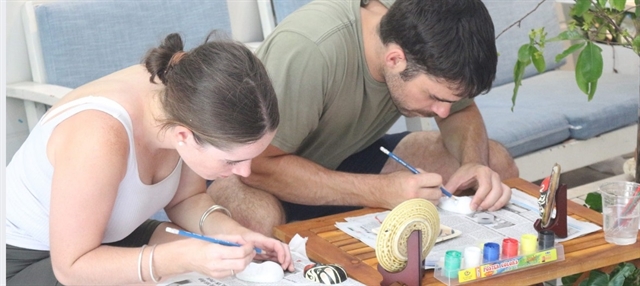 Society
Society

Having failed to enter public high school, Võ Hoàng Khoa from HCM City’s outlying district of Củ Chi applied to enroll at the district’s Centre for Continuing Education.
10450509PM.JPG) |
| Students study at a centre for continuing education in HCM City. —VNS Photo Trinh Ngọc |
Gia Lộc
HCM CITY — Having failed to enter public high school, Võ Hoàng Khoa from HCM City’s outlying district of Củ Chi applied to enroll at the district’s Centre for Continuing Education.
“Before studying at the centre, I felt discouraged because of earlier failure,” Khoa said.
Like most students in Việt Nam, Khoa felt huge pressure when he took the entrance exams for public high school, which is the favoured place to study.
This year in HCM City, nearly 70 per cent of 86,881 secondary school students who took the exam passed and entered public high schools.
The students who did not pass the exam chose to enroll in centres for continuing education, vocational training schools, or private high schools.
Three years ago, after failing the exam, Khoa sought admission in the Củ Chi District Centre for Continuing Education.
“It was the correct choice. The centre’s teachers were enthusiastic and I was not under pressure,” Khoa said.
Since the centre’s training programme and extracurricular activities are the same as public schools, students are provided detailed explanations for each lesson.
Thanks to this teaching method, Khoa scored 18.25 for three subjects on this year’s national high school graduation exam, higher than most other students at public high schools.
“I’m proud of studying at the centre for continuing education,” he said.
Khoa is now enrolled at the HCM City University of Education’s social work faculty. Many of his former schoolmates at the centre are also attending universities and colleges in the city.
Because of the improved quality of centres for continuing education, more students are choosing to attend classes there.
Huỳnh Tấn Thanh, director of the Chu Văn An Centre for Continuing Education in District 5, said that 605 students had enrolled as of August, an increase of 263 compared to the previous academic year.
The centre is also an ideal place for students with disabilities, Thanh said, adding that it has seven visually impaired students.
Since September last year, all 24 centres for continuing education have merged with vocational training centres and general technical and occupational consulting centres.
According to the city’s Department of Education and Training, the city has 30 centres for vocational training and continuing education with more than 1,000 teachers and 21,350 students.
To improve teaching quality, the teachers at the 30 centres use modern teaching methodologies.
Many students at the centres have won prizes in contests for outstanding students, such as Olympiad contests.
Favourable conditions have also been created for students to develop their creativity and problem-solving skills, according to the department.
The department has also upgraded or built new facilities at the centres.
Vocational training schools
Like centres for continuing education, vocational training schools in the city have seen an upward trend in enrollment.
Văn Công Lộc, rector of the Bình Thạnh District Vocational Training School, said the school was working with 15 secondary schools in the district to provide guidance on careers and academic pathways in the last two years of school.
“Before the high school entrance examinations, the secondary schools screen students who have a low academic level and give them information about centres for continuing education and vocational training schools,” Lộc said.
Lộc’s school has benefited from the screening and guidance. In the 2017-18 academic year, the school enrolled 294 students in eight departments.
As of July it had received 190 students, and expects to see an increase this month for the 2018-19 year.
At vocational training schools, students are also taught academic courses that contain the same subject matter as other schools.
After graduation, students receive a certificate for finishing the high school academic programme, which allows them to transfer to colleges and universities.
“Students are provided vocational training without charge, because subsidies from the local authorities cover the fee,” Lộc said.
Vocational training schools have also updated their training curricula to meet labour market demands.
Lộc’s school, for instance, has been working with companies to offer internship opportunities to students.
Đặng Minh Sự, head of the Vocational Education and Training Division at the city’s Department of Labour, Invalids and Social Affairs, said the city People’s Committee had launched many programmes to improve vocational training schools, with the aim of raising the skill level of human resources needed for the city’s development. — VNS









